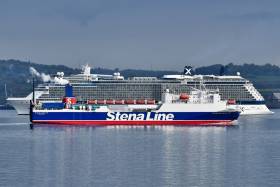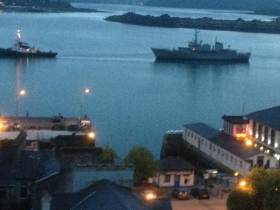Displaying items by tag: End of An Era
Numbering a handful of men that still tend Ireland's lighthouses, but a move, writes Independent.ie, to renewable energy is bringing their unique way of life to an close.
'I can think of no other edifice constructed by man as altruistic as a lighthouse," George Bernard Shaw once said. "They were built only to serve."
Even after the leap in navigational technology represented by GPS, they maintain that historical function: shining a light for miles around, warning sailors and ships of dangers lurking beneath the surface.
The way they are powered is changing, though, and with it the work of the people who tend them.
The tradition of constantly manned lighthouses ended on March 24, 1997, but the lightkeepers' cottages are still inhabited for weeks at a time by maintenance staff who service the lights' diesel-powered motors.
Today, Irish Lights workers travel to sites including Fastnet Rock off Co Cork, Tuskar Rock off Co Wexford, Inishtrahull Island off Co Donegal, Slyne Head off Clifden in Co Galway and Kish Tower in Dublin Bay.
By 2025, however, all lighthouses, beacons and buoys dotted around the coast and in Irish waters will be powered by renewables. The amount of work for technicians who stay at remote lighthouses will fall.
To read more here including from Yvonne Shields O'Connor, chief executive of Irish Lights which is withdrawing from lighthouses' accommodation quarters.
Dublin Port Ban Could Bring Fears Signalling An 'End of an Era' for Cruiseships in Belfast
An enormous cruiseship Celebrity Reflection sails into Belfast this morning, bringing thousands of deep-pocketed North Americans to the city's visitor attractions, shops, pubs and restaurants, there are fears it could be the 'end of an era' for this type of tourism.
As The Irish News reports, it comes as the Dublin Port Company sticks to its guns and restricts the number of cruise ships entering its port from 2021 as it increases freight capacity container vessels post-Brexit.
And when cruise ships can't dock in Dublin, then Ireland as a whole could be wiped from tour itineraries - which will impact heavily on Belfast.
In what is known in the industry as a 'turnaround', the Celebrity Reflection dropped off 3,600 cruise tourists in Dublin yesterday while another 3,600 passengers flew into Dublin to begin their cruise, which has Belfast as its next stop today.
Dublin port sees freight (where volumes have swollen by 36 per cent in six years) as more lucrative than cruisers, and last month confirmed the number of tour vessels it will allow to berth will be slashed from 172 in 2019 to as few as 30 in just two years.
Click here to read more on the story.
RMS St. Helena: What Was It Like to Sail Aboard the Final Voyage
#Ports&Shipping - RMS St. Helena, the last ever Royal Mail Ship completed its last ever journey – and it was surprisingly emotional, says Jonathan Hollins writing in the UK's Independent newspaper.
The word “lifeline” is one too often bandied about and devalued; but, in the case of the Royal Mail Ship St Helena, it is entirely appropriate. In fact, she is its very definition.
For 27 years now, since her shiny new hull first slipped through the murky waters of Cardiff Bay in 1990, the RMS – or “Betty Blue Bucket”, as she is affectionately called – has plied the mid-Atlantic, nurturing Britain’s remote overseas territories and linking them to civilisation. Central to these rocky outcrops is the island of St Helena: sea lashed, cliff bound, the one-time darling of the Honourable East India Company, and haven to over 4,000 “Saints”, as locals are known.
The RMS is the last of her species, the only working royal mail ship left of a fleet that used to string together the distant strands of empire. Two other ships carry the title, but it is only honorary.
The RMS was purpose-built by the UK government, a 105m vessel able to carry 7,000 tonnes of cargo and passengers, all cocooned in a dark blue hull with white topsides, and crowned by a mustard yellow funnel bearing a golden merlion.
Now, however, the fatal day has come. St Helena, formerly the second most remote island in the world, has built an airport, a masterpiece of engineering bedevilled and delayed by topography, and after a two-year reprieve (see Afloat's coverage of once-off London visit) the RMS has completed her final voyage.
For much more on this historic final voyage and photos taken on the momentous day on and offshore of St. Helena Island, click here.
As Afloat reported last October, the passenger-cargoship owners St. Helena Line had appointed the sale of the ship through a London based ship-broker.
Sea transport services will continue albeit with a cargo-only service on the same route operated by A.W. Ship Management. This new service is scheduled to begin tomorrow voyage (No. 1) using the M.V. Helena.
#FarewellAisling! - The former LÉ Aisling which was sold at public auction this date last month departed Cork Harbour for the final time last night marking an end of an era, writes Jehan Ashmore.
The 36 year old Offshore Patrol Vessel (OPV) was sold by auctioneer, Dominic Daly at public auction for €110,000 to Dick van der Kamp Shipsales B.V. They plan to refurbish the 65.2m ship renamed Avenhorn as previously reported on Afloat.
The refurbishment is to take place in the Netherlands to where she is bound while under tow of the tug Ocean Bank. The pair having departed the basin of the Naval Base on Haulbowline Island opposite Cobh.
On completion of these works, the Belize registered Avenhorn is to be re-sold by the Dutch shipbroker.
LÉ Aisling represented the sole surviving ‘Emer’ class that totalled three that were commissioned by the State for the Naval Service. In 1979 the OPV was completed by Verolme Cork Dockyard and she entered service the following year.
Notably, LÉ Aisling made history in the Naval Service as the first to be commanded by a female officer, Lieut Cdr Roberta O'Brien. This took place in 2008. Also significant is that O'Brien became the first woman to enter the ranks of the Naval Service.
It was in Galway Docks in June 2016, that LÉ Aisling was officially decommissioned in a ceremony in the mid-west port to where strong links were made given the ship was twinned with the city.
Among the highlights of her career, LÉ Aisling intercepted and arrested the trawler Marita Ann for smuggling arms for the IRA in 1984.
The OPV in the following year was on the scene of the Air India disaster that took place 120 miles off the south west coast of Ireland. Several crew members were decorated for bravery, having entered shark-infested waters to recover victims of the bombing.
In addition to performing routine fishery patrols that involved 5,579 vessels and in the detention of 222 vessels for infringements in Irish waters.
































































